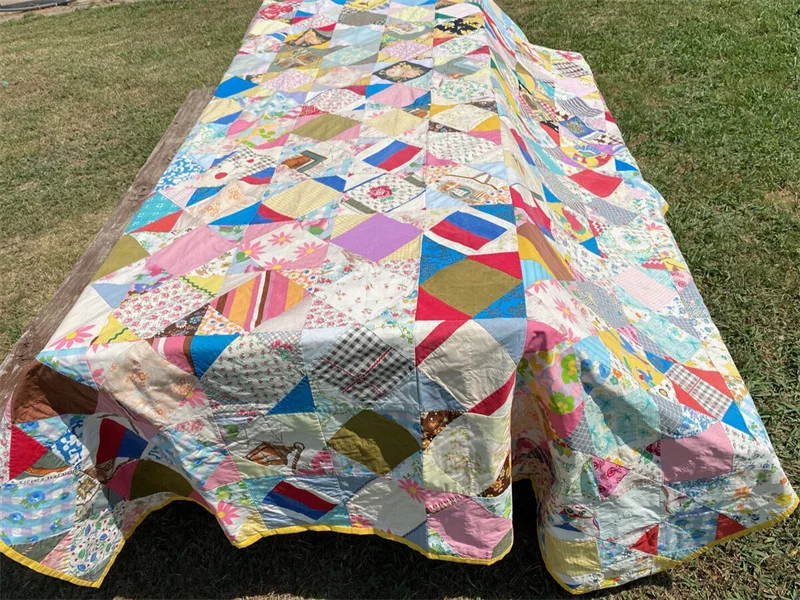Washing a cotton quilt can be tricky because if not done correctly, it can damage the fabric or cause the quilt to bunch up, ruining the softness and structure of the quilt, making it hard and sometimes lumpy and unusable.
Learning “How to wash a quilt with cotton batting” will help maintain its durability, softness, and overall appearance.
In this guide, we’ll cover everything you need to know about cleaning your quilt, whether you choose to machine wash or hand wash it, to ensure it stays in pristine condition for years to come.

Check the Care Label
Before you start washing your quilt, the first step is always to check the care label.
Manufacturers usually provide specific washing and drying instructions based on the materials used. Some quilts may have special washing requirements, and ignoring these requirements may cause damage to the fabric or the quilt inside.

What to Look For:
Care labels usually contain material descriptions, symbols, or clear instructions that tell you what the quilt is made of and whether it can be washed in a machine or only dry cleaned.
If it is washed in a machine or only by hand. Washing in the right way will make your quilt unusable.
Pay attention to these suggestions, as they are designed to extend the life of your quilt.
Common symbols explained:
- The bucket symbol indicates machine wash, usually accompanied by a temperature setting (such as cold water).
- The hand in the bucket symbol means hand wash only.
- A circle with a letter usually means dry clean only.
When learning how to wash a quilt with cotton batting, checking the care label can help you avoid costly mistakes. This is the first line of defense in quilt care.
Next, let’s discuss water-washed quilts, step by step.
Preparation before washing
Test color fastness
First, you must test for color fading, especially those with bright or dark colors, which may fade during the washing process.
To test color fastness, wet a small hidden area of the quilt with cold water and a little detergent. Press the wet spot with a white cloth.
If the color transfers to the cloth, that is, it fades, the fabric may not be suitable for machine washing. You can only choose to hand wash or machine wash the same color together to avoid the color of the fabric transferring to each other, causing the overall color to become mottled, which is probably not the color you like.

Local cleaning
Whether it is machine washing or hand washing, it is recommended to do local cleaning first, focus on the stained part, and then do large-scale cleaning.
Before immersing the quilt in water, be sure to deal with any visible stains. Use a mild detergent and a damp cloth to gently wipe the stained area. You can use some soft brushes to scrub it, which will be faster and clean very cleanly.

Special note: Always use cold water, because warm or hot water may make the stain penetrate the fabric and make it more difficult to remove.
Avoid using harsh chemicals:
Bleach and strong detergents will damage the fabric and the cotton wool inside the quilt.
Tools you need
- Large washing machine or hand wash bucket.
- Mild detergent, preferably without fragrances and harsh chemicals.
- Cold water.
- A clean, flat surface or clothes rack for air drying.
Why cold water?
That’s why: Cotton batting is sensitive to heat. Using cold water protects the fibers and ensures that the batting doesn’t shrink or clump.
How to machine wash a quilt with batting
If your quilt is machine washable, follow these guidelines to ensure it stays intact during the wash.

Choose the right detergent
First, it’s important to use a mild, gentle detergent when washing your quilt. The harsh chemicals in strong detergents can damage the batting and quilt fabric over time.
Avoid fabric softeners, as they coat the fibers in the quilt and affect the natural breathability of the batting.
Use only cold water
Always wash a quilt with batting in cold water. Hot water can cause the batting to shrink or lose its softness. Using cold water also helps prevent the quilt from fading.
Use a gentle wash cycle
After spot cleaning, we can use machine washing to free our hands.
When washing, it is recommended that your washing machine should always use the gentle or delicate wash cycle to wash your quilt.
This reduces fabric agitation and helps prevent wear and tear on fabric and lint.
Avoid overloading your washing machine
Washing your quilt in an overloaded machine can result in uneven cleaning and stress on fabric.
Your quilt needs enough room to move freely in the water to ensure thorough cleaning.
If your washing machine is too small, consider hand washing (as described below) or taking your quilt to a laundromat with larger machines.
How to Hand Wash a Cotton-Woven Quilt
For delicate quilts or quilts with intricate designs, hand washing may be the best option to prevent damage.

Step-by-step hand washing instructions
- Fill the tub with cold water:
Use a large tub or basin filled with cold water to submerge the quilt. Make sure there is enough room for the quilt to move freely. - Add mild detergent:
Add a small amount of mild, fragrance-free detergent to the water. Agitate the water with your hands to evenly distribute the detergent. - Soak the Quilt in the Water:
Gently press the quilt into the water, making sure it is completely submerged. Soak for about 10-15 minutes to allow the detergent to loosen any dirt or stains. - Gently Agitate:
Gently agitate the quilt in the water with your hands to release any trapped dirt. Gently scrub the localized stain area with your hands to keep it clean.
Be careful not to wring or twist the quilt, as this may damage the cotton wool. - Rinse Thoroughly:
Pour out the soapy water and refill the tub with clean, cold water. Submerge the quilt in the water again, agitate gently, and rinse thoroughly. Repeat this process until all the soap is removed, changing the water as necessary. - Squeeze out excess water:
After rinsing, gently press the quilt against the sides of the tub to remove excess water. Avoid twisting or wringing the quilt, as this will deform the cotton wool inside.
Dry the Quilt with Cotton wool
Air Dry:
The best way to dry a quilt with cotton wool is to air dry it. Lay your quilt flat on a clean surface, such as a large table or drying rack.
This prevents the batting from bunching up inside the quilt. Make sure the quilt is spread out evenly so it dries evenly, and avoid leaving it in direct sunlight, which can cause fading.

Drying:
If the care label allows, you can dry your quilt on a low heat setting.
However, this should be done carefully, as high temperatures can cause the batting to shrink. Place the quilt in the dryer along with some clean tennis balls or dryer balls to help the batting fluff up as it dries.
Drying Tips:
- Avoid hanging your quilt in one corner, as the weight of a wet quilt can stretch the fabric and cause uneven drying.
- Fluff the quilt occasionally during the air-drying process to keep its shape and ensure even drying.
After air-drying, you can also gently tap it with a wooden stick to make the quilt fluffier.
Care for your quilt after washing
Proper care between washes is key to keeping your quilt in good condition. Here are some tips:
Storage
Store your quilt in a dry place. If it is a cotton quilt, you can dry it in the sun when the weather is good, which can increase the fluffiness of the quilt.
Avoid using plastic bags or sealed containers, because the quilt needs to breathe. Instead, choose a cotton storage bag or a breathable fabric cover.
Washing frequency
Unless it is used frequently, it is generally recommended to wash a quilt with cotton batting only once or twice a year. Frequent washing will cause the fabric and cotton batting to wear out over time.
Dust and sun protection:
If your quilt is displayed or used every day, consider placing a layer of lightweight cotton cloth over it to prevent dust. In addition, long-term exposure to sunlight will fade the fabric, so try to avoid direct sunlight on the quilt as much as possible.
If it is a pure cotton quilt, it is not afraid of direct sunlight. On the contrary, it will be softer in the sun, but other materials should refer to the care label.
FAQ: How to wash a quilt with cotton batting
1.Can I use bleach to clean a cotton batting quilt?
No, bleach should be avoided as it weakens the fabric and causes the batting to break down over time.
2.How often should I wash a batting quilt?
It’s best to wash it once or twice a year unless it’s very dirty.
Try to wash it less often. Pure cotton quilts can be dried more often. We can also put a quilt cover on the quilt to reduce the number of times we wash it.
3.Can I use a dryer to dry a batting quilt?
Yes, but only on a low temperature setting, and be sure to add dryer balls to help fluff up the batting.
4.Which detergent is best for washing a batting quilt?
Use a mild, fragrance-free detergent and don’t use bleach or harsh chemicals.
5. Can I iron a batting quilt?
Ironing is generally not recommended because it can flatten the batting and damage the quilt.
6. How do I remove wrinkles from a batting quilt?
Lay the quilt flat and gently smooth out any wrinkles with your hands. Alternatively, hang the quilt in a steam room to let the fabric relax naturally.
By following the steps in how to wash a quilt with cotton batting, you will ensure that your quilt remains clean, soft, and in great condition for years to come. Proper care helps maintain the beauty and functionality of your quilt, making it a treasured item in your home.
If you have any other questions, please feel free to leave a message, or you can click on our website to view more information.
